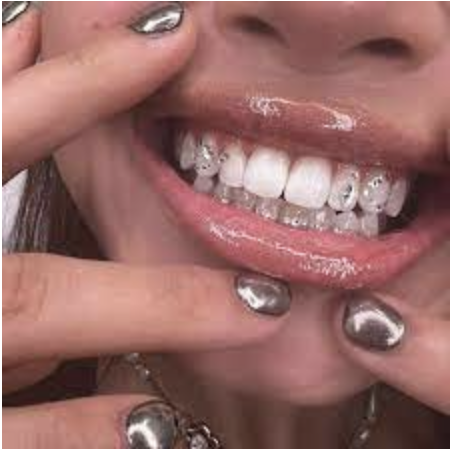Teeth Whitening and Dental Gems
Teeth Whitening
Teeth Whitening
Smiling is critical to your appearance, especially when your teeth are stained and dark, which affects many people's self-esteem. For that reason, many individuals decide to have teeth whitening.
How teeth whitening works
Teeth whitening consists of carbamide peroxide or hydrogen peroxide that penetrates the enamel of your teeth to reach the discolored molecules inside your tooth. The oxygen molecules in carbamide peroxide or hydrogen peroxide react with the discolored molecules on the teeth, breaking the bonds that hold them together. If done correctly, it is a safe treatment for adults and adolescents.
Why Teeth Darken
Dental darkening occurs due to chromophores (pigments) impregnated in the structure of the tooth for a variety of causes, such as: trauma, intracanal medication, hemorrhages in the internal structure of the teeth, among other causes. When these pigments form a molecule capable of reflecting light at a wavelength visible to the human eye and whose intensity is greater than the light reflected by the structure of the tooth, then the color of the pigment predominates and the darkened tooth is observed.
Causes of Darkening
The causes of darkening of the teeth can be a consequence of factors, extrinsic or intrinsic, congenital or acquired. Extrinsic spots are very frequent, and are usually acquired from the environment. They are associated with the abusive consumption of coloring substances such as coffee, tea, mate, some soft drinks, the presence of dyes in food, smoking, plaque accumulation and the use of some types of medications. Intrinsic alterations, on the other hand, are much more complicated and difficult to treat, and may be congenital, related to tooth formation or acquired by dental trauma.
Side effects
Teeth whitening is a very safe procedure when done correctly. However, the process may cause certain side effects that the practitioner must inform the patient before the procedure. The two most common side effects are a temporary increase in tooth sensitivity and mild irritation of the soft tissues of the mouth, particularly the gums. Tooth sensitivity usually occurs during stages. Initial bleaching treatment. Tissue irritation is usually due to a poorly fitting mouthpiece tray instead of tooth-whitening agent, both conditions are usually temporary and disappear between 1 and 3 days after discontinuation or completion of treatment.
Teeth Whitening & dental gems
A new fashion trend is appearing! Dental gems! We've seen them on our favorite celebrities from Hollywood to New York, but what are they?
Dental gems are a small crystal that is attached to the surface of a tooth. Dental gems adhere to tooth enamel in the same way orthodontic brackets are placed. They are completely safe and can give a subtle or dramatic touch and shine to your smile.
In this procedure it is not necessary to pierce the tooth. It is a quick and painless process, and can be easily removed at any time by a professional.
How Long Does Dental Gem Placement Take
The placement of a Dental Gem is a painless procedure of 20-30 minutes (the time may vary depending on the number of dental gems received or the design of dental gems chosen by the client).
How long dental gems last
Dental Gems are semi-permanent and can last between 3 months and 2 years with proper care and do not obstruct regular tooth brushing. However, you need to be very careful about how you take care of them.
Aftercare
Don't brush your teeth too hard.
Do not eat for at least 1-2 hours after placing the gems.
Do not bite food or hard objects.
Do not use an electric toothbrush directly on the teeth with the gems
Teeth Whitening & dental gems application $120 | 60min
Flat Back Tooth Gold 14K and Swarovski Crystal gems available upon request and as an Add On.




